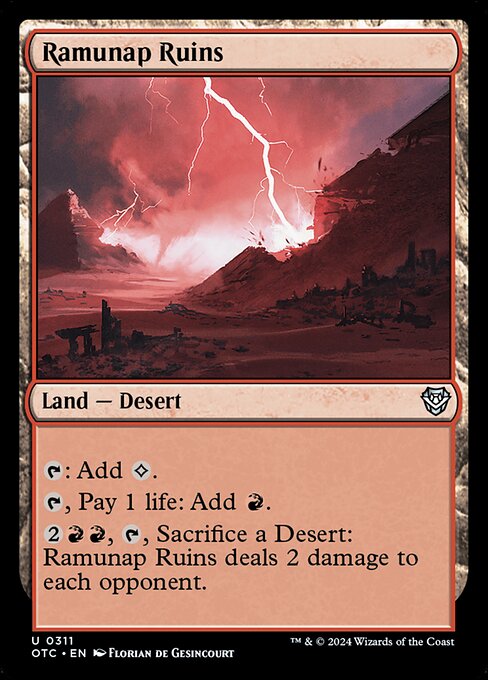
Image courtesy of Scryfall.com
Desert Suns and Ruined Temples: The Lore Behind Ramunap Ruins
Some cards arrive with a mere line of stats, and others unlock a tectonic story you can feel in the bones of a table: when you glimpse Ramunap Ruins, you’re stepping into a sun-bleached chapter of Amonkhet where a desert civilization carved power from the heat itself 🧙♂️🔥. This land—a Desert that doesn’t ask for your budget or your patience—asks you to weigh risk against reward, to treat life as both resource and catalyst, and to remember that even ruined stone can spark a red-hot finish. In the context of Outlaws of Thunder Junction Commander, it’s a reminder that the past keeps pace with present ambitions, especially when you’re weaving a desert-centered strategy with a touch of danger. 💎⚔️
The card’s mana economy is a tiny sculpted drama, a microcosm of red’s hunger and the harsh climate of Amonkhet. Tapping to produce colorless mana is the safe, steady initial beat—the kind you reach for in the early turns as you set up your board. Then the activation to add red mana at the cost of 1 life is a classic red flourish: you’re paying a little to ignite faster development or to push through a crucial one-mana step. The real crescendo arrives when you spend two colorless and two red, tap, and sacrifice a Desert to unleash two damage to each opponent. It’s not just damage; it’s a ritual—a desert rite that can slam a multi-player table into new fearsome tempo. The design anchors itself in theme: deserts aren’t merely weather; they’re tests, and Ramunap Ruins is a test with a built-in blast radius. ⚡🎲
Artist Florian de Gesincourt renders the desert as a place where memory and sun collide—the ruins hold glyphs that glow faintly under a relentless glare, telling stories of builders who bargained with flame and time. The flavor mirrors the broader lore of Amonkhet, where mortals learned to shape fate through sacrifice, ritual, and clever use of what the land itself provides. Ramunap Ruins stands as a portal between the old world and the deck you’re crafting today: a way to honor the desert’s stubborn resilience while leaning into red’s bold, risk-embracing tempo. The result is a card that speaks to nostalgia for a world you’ve only half-remembered and a hunger to rewrite it in your own games. 🎨🔥
Why this land matters in gameplay and storytelling
Beyond the pretty art and evocative lore, Ramunap Ruins is a practical centerpiece for several deck archetypes. As a Desert land, it slots into desert-centric themes from the Amonkhet era—where deserts are not just terrain but resources to be tapped, traded, and sacrificed for greater effect. The dual mana capability—colorless first, red with life as fuel—helps accelerate red strategies that want to threaten or finish by mid to late game. And the big payoff, when you have a Desert on the table and enough mana to spare, can swing a game in a single moment, especially in multiplayer formats where the damage-to-all- opponents clause has significant salt-sprinkling potential. 🧙♂️💥
In Commander circles, the card shines as a flexible piece of a broader Desert synergy. It invites you to lean into deserts not merely as a theme but as a resource network: other Desert cards, desert-tied effects, and mana acceleration that rewards you for leaning into risk in pursuit of a dramatic impact. The fact that it’s an uncommon reprint in a Commander-themed set makes it approachable for players building around a desert motif or those who simply want a flavorful, reliably playable land in red-heavy decks. The balance between early ramp and late-game reach mirrors red’s identity: fast starts, high impact turns, and a willingness to pay a price to push pressure across the table. ⚔️
For lore aficionados, the Ramunap ruins aren’t just a backdrop; they’re a narrative engine. The desert’s ruins symbolize the enduring memory of a people who thrived in adversity, a society whose monuments still whisper under the sand where risk and ritual coexisted. The card’s text is a compact homage to that idea: a land that gives, costs, and finally blasts your opponents, all under the sun that shaped their world. It’s the kind of synergy that makes you grin at the table and whisper, “The desert remembers.” 🧡🌵
- Flavor-forward design: Desert-themed mechanics anchor a lore-driven feel that’s instantly recognizable to Amonkhet-era fans.
- Strategic flexibility: Early colorless ramp, late red reach, and a powerful multi-opponent burn potential with a desert sacrifice payoff.
- Commander-friendly: Works nicely in Desert or red-centric builds, offering a reliable engine in multi-player formats where cavalry charges (or spells) need momentum.
Whether you’re a collector, a lore devotee, or a player chasing that perfect red-tinged finish, Ramunap Ruins offers a sturdy blend of story and strategy. It’s a reminder that in Magic, the landscape is more than scenery—it’s a toolkit, a challenge, and a doorway to new narratives around every table turn. 🧙♂️🎲